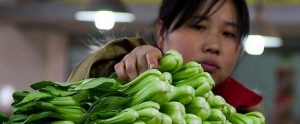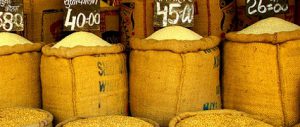The following extract, published with permission, is from the Worldwatch Institute’s State of the World 2011: Innovations That Nourish the Planet. The full report is available from Earthscan (non-US readers) and Worldwatch (US readers).
New Forest Farm is nestled in the Kickapoo Valley 130 kilometers west of Madison, Wisconsin. In the summer of 2008, the state—and much of the US Midwest—was deluged with unseasonal downpours, and large tracts of farmland were flooded. The heavy rains and flooding caused $15 billion in damages and left 24 people dead across the Midwest. Wisconsin declared a state of emergency. Yet on a visit just weeks after the rainstorms had swept the region, Mark Shepard of New Forest Farm does not seem beaten down at all.
Shepard is lounging on the porch of his newly constructed cider mill, powered by solar panels and a soon-to-be built windmill. His farm is bursting with life: undulating fields of bush cherries, Siberian peas, apricots, cherries, kiwis, autumn olives, mulberries, blueberries, rosehips and asparagus, hickory nuts and oak, apples and chestnuts, and more. He escaped devastation from the deluge, he says, not by luck but by savvy farming.
It is a kind of farming that created these resilient fields and that puts Shepard at the heart of a movement scattered from the verdant valleys of the US Midwest to South Korea, from the foothills of the Himalaya to the plains of southern Brazil. It goes by many names, but it is fundamentally about following agro-ecological principles. Shepard and like-minded farmers around the world are proving that a sustainable and abundant food system need not rely on fossil fuels. They are also showing how these climate-friendlier farms can help the world adapt to the climate crisis at the same time. Extreme weather events like the floods that swamped Wisconsin are only going to be more common as the climate destabilises because of ever-greater greenhouse-gas (GHG) emissions, including those from the food and agriculture sector.
The climate crisis and its main drivers generally conjure up images of dirty coal-fired power plants or fuel-guzzling sports utility vehicles. Yet the food industry and agribusiness are among the biggest contributors to climate change. In many developing countries without significant heavy industry, agriculture is in fact the most important source of greenhouse-gas emissions, largely because of its role in deforestation.
Farming, especially industrial-scale production of livestock on factory farms, is among the biggest drivers of deforestation. As forests are cleared, the trees release enormous amounts of carbon into the atmosphere along with other greenhouse gases, including methane and nitrous oxide. The loss of forests contributes more than 17% of human-made emissions of carbon dioxide. Globally, livestock production accounts for 18% of global emissions, according to the United Nations. New Zealand’s ruminant livestock animals produce 85% of that country’s emissions of methane—a greenhouse gas far more potent than carbon dioxide.
Greenhouse-gas emissions from food occur at every step in the food chain: farming, processing, packaging, transportation, wholesale/retail, food service, household consumption and waste. Account for all the direct and indirect emissions—including land-use changes, the production of farm chemicals and synthetic fertiliser, and fossil fuel energy use throughout the supply chain—and the food system is responsible for as much as one-third of global GHG emissions. These emissions can largely be traced back to a radical remaking of agriculture and food systems in the twentieth century, first in the industrial world and then in developing countries.
But it does not have to be this way. Innovative farmers like Mark Shepard are showing the potential of sustainable farms to feed the world while not depleting its finite resources like fossil fuels and not exacerbating the climate crisis. Sustainable farmers use a variety of techniques and innovations to protect against weeds and pests and to boost soil fertility without relying on fossil fuels or synthetic pesticides. Some of these techniques include using cover crops, crop rotations and beneficial insects. Farmers like Shepard are also beginning to generate their own energy—in his case, through wind turbines and solar panels. Small-scale methane digesters can also convert animal waste into usable energy.
Sustainable farming techniques build healthy soil, which benefits plant health and climate stability. In side-by-side field trials over 30 years, the US-based Rodale Institute found that corn and soybeans raised with organic techniques stored more carbon in the soil year after year. In a review of these field trials, Cornell University professor David Pimentel found that the organic farming methods produced the same yields of corn and soybeans as did industrial farming, but they used 30% less energy, less water and no synthetic pesticides. Based on these lessons, former Rodale Institute chief executive officer Timothy LaSalle estimates that if 434 million acres [nearly 176 million hectares] of cropland in the United States shifted to organic production, nearly 1.6 billion tons [1.45 billion tonnes] of carbon dioxide could be sequestered annually, “mitigating close to one quarter of the country’s total fossil-fuel emissions.”
These findings, and similar results from research around the world, are remarkable, for they point to the potential of agriculture to help mitigate climate change. Furthermore, research shows that sustainable farms are also better able to withstand the climate instability triggered by the greenhouse effect. At Rodale, researchers found that the organic test fields did better during dry years, “thanks to improved water-holding capacity of the extra soil organic matter,” says LaSalle.
On a global scale, the shift away from petrochemicals in the food supply need not threaten food productivity. In one meta-study of yields from organic and industrial farms around the world, researchers from the University of Michigan found that introducing agro-ecological approaches in developing countries led to two to four times greater yields. Estimating the impact on global food supply if all production shifted to organic farming, the authors found an average yield increase for every single food category they investigated.
In one of the largest studies of how agro-ecological practices affect productivity in the developing world, researchers at the University of Essex in the United Kingdom reviewed 286 projects in 57 countries, mostly in Africa. Of the 12.6 million farmers who were transitioning to sustainable agriculture, the researchers found an average yield increase of 79% on farms. A 2008 UN Conference on Trade and Development and UN Environment Programme report concluded that “organic agriculture can be more conducive to food security in Africa than most conventional production systems, and … is more likely to be sustainable in the long term.”
In the most comprehensive analysis of world agriculture to date, the International Assessment of Agricultural Knowledge, Science and Technology for Development (IAASTD) found that “reliance on resource-extractive industrial agriculture is risky and unsustainable, particularly in the face of worsening climate, energy and water crises,” according to Marcia Ishii-Eiteman, a lead author of the report.
The IAASTD study, the University of Essex findings, the Rodale Institute’s conclusions and Mark Shepard’s abundant fields all point in one direction: If we are to continue to feed the planet — and feed it well — in the face of global climate chaos, we should be radically rethinking the industrial food system. We can start with what is on our plates.
We can make food choices in line with a climate-friendly diet. We can choose to eat foods from sustainable farms, reduce consumption of highly processed foods, and cut back — or cut out — meat and dairy that comes from factory farms. We can also reach for local and regionally grown foods. (Even though transportation-related emissions are a relatively small segment of the overall impact of most food items, choosing to support regional farmers is an important part of building a resilient, biodiverse food system.)
But it is important not to stop there. At least for now, climate-friendly choices are unavailable in most communities, largely because agricultural policies in the United States and elsewhere have been providing incentives for industrial production for decades — at the cost of sustainable producers. US industrial livestock producers receive billions of dollars in direct payments etched into the Farm Bill, the multi-billion-dollar policy that governs food and farming. From 1995 to 2006, the Farm Bill legislation paid nearly $3 billion in direct subsidies to large-scale livestock producers.
Livestock producers benefit from the US Farm Bill in indirect ways, too. Between 2003 and 2005, corn producers received $17.6 billion in subsidies, and soybean producers another $2 billion. Because feed costs usually account for 60% or more of the total cost of production for most factory farm operators, policies that enable grain and soy prices to fall below the cost of production are a boon to processors and retailers. And since 67% of US corn and nearly all of the soybean meal are used for domestic or overseas livestock or fish feed, these commodity subsidies could also be seen as livestock industry subsidies.
In total, these federal subsidies saved the factory livestock sector an estimated $35 billion between 1997 and 2005, according to researchers at Tufts University. Livestock industry lobbyists also succeeded in getting payments from the Farm Bill’s Environmental Quality Incentives Program (EQIP) for concentrated animal feeding operations, even though the programme was designed to help small-scale farmers reduce pollution. By 2007, factory farms were receiving as much as $125 million a year from this programme alone.
These are just some of the “perverse” farm policies that are providing incentives to further a food system that is contributing to the climate crisis. But the Farm Bill could instead encourage a shift away from fossil-fuel-dependent agriculture and toward an agricultural system that is part of mitigating the climate crisis. It could, for instance, provide:
• farmer education to facilitate the transition from chemical agriculture to organic farming;
• broader incentives for farmers who make the transition and financial support to subsidize the costs of organic certification (in 2009, the EQIP Organic Initiative set aside more than $35 million in assistance for certified and transitioning organic farmers);
• incentives and support for all farmers to build healthier, carbon-rich soil matter and to reduce the use of synthetic fertiliser;
• greater enforcement of environmental regulations for emissions-intensive factory farming and commodity crop production; and
• research dollars to explore how to reduce on-farm greenhouse-gas emissions (currently only 2.6% of the US Department of Agriculture’s research budget goes toward organic approaches).
The Farm Bill could also expand its programs that encourage consumption of fruits and vegetables and local foods instead of highly processed products. The WIC Farmers Market Nutrition Program, for example, operates in 45 states and provides up to $30 a year in vouchers to low-income children and to pregnant and post-partum women for redemption at farmers’ markets. Reaching 2.2 million people, this programme could be significantly expanded, fueling greater consumption of climate-friendly foods and fueling regional food systems.
These are just a few of the policy changes that could help shift the food system. While speaking up for policy reform, individuals can help provide market demand for climate-friendly foods by following the principles of a climate-friendly diet.
Yes, we cannot change the world just by buying organically grown apples from the neighborhood farmers’ market, but it’s a start.
Anna Lappé is a co-founder of the Small Planet Fund and author of Diet for a Hot Planet: The Climate Crisis at the End of Your Fork and What You Can Do About It.
This extract, published with permission, is from the Worldwatch Institute’s State of the World 2011: Innovations That Nourish the Planet. The full report is available from Earthscan (non-US readers) and Worldwatch (US readers). State of the World 2011: Innovations That Nourish the Planet © Copyright 2011, Worldwatch Institute
Homepage image by René Piamonte


